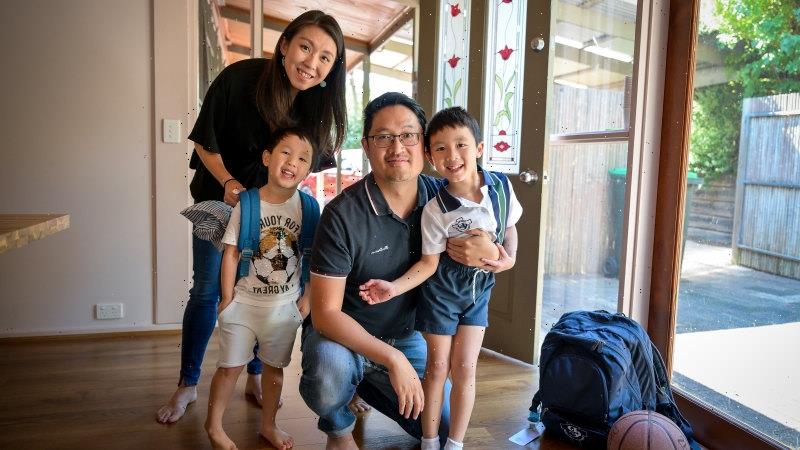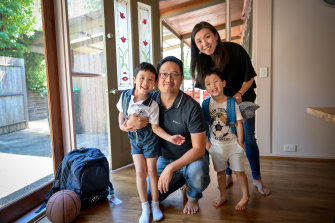During lockdown, Phoebe Tan rolled out of bed at 7.30am before enjoying a leisurely breakfast with her husband and two sons and logging onto work at home.
She didn’t have to worry about packing lunches or school bags, and prepped dinner and did household chores at lunchtime or between meetings.
Phoebe Tan, with husband Adrian and their sons Aiuden-James and Lucas. Credit:Eddie Jim
Now that Ms Tan is in the office three to four days a week, she gets up an hour earlier and scrambles to get her sons, aged 6 and 4, to school and daycare, before driving in traffic for an hour to work.
She often forgets important tasks, such as making lunch orders or dressing her older son for casual clothes day.
“There are a number of things that we’re trying to squeeze into a very limited timeframe,” she said. “We are constantly rushing. The juggle is real.”
Evenings were even worse for the family, she said. Ms Tan gets home around 5.45pm and has to have dinner on the table 15 minutes later to get her sons asleep on time.
This means meal prepping the night before, along with doing the laundry and other tasks.
It all equals little time to herself.
However, Ms Tan, who struggled starting a new job while working from home full-time in January, sees the benefits of office life and wants to spend at least some time there.
Research from University of Melbourne’s Future of Work Lab has found workers want to return to the office, but they also want to decide how often and what time they start and finish.
Early results from its Building a Better Future of Work survey found 77 per cent of 80 Australians, half of whom are parents, want more flexibility.
While 87 per cent reported interacting with colleagues in person as a positive, 93 per cent want to work from home at least sometimes to manage personal demands.
The most common post-lockdown employment model is for Australian businesses to mandate a fixed number of in-office days, often three days in the office, two at home. Some allow workers to choose which days they come into the office, while others don’t.
The lab’s founding director, sociologist Leah Ruppanner, who has also recently interviewed 50 Australian and American women, issued a warning to companies: If they don’t provide workers with greater flexibility to chose their office hours, Australia could see the global trend The Great Resignation, or something close to it, hit our shores.
“Strong-arming your employees back into work is going to backfire,” she said. “Get ready to see a haemorrhaging of women, caregivers, and probably young people, out of your workforce.”
Professor Ruppanner said the pandemic had led to a burnt-out workforce, especially for working parents, and that businesses were failing to acknowledge it.
University of Sydney researchers have similarly found that women will quit if not given flexibility.
While the Victorian Chamber of Commerce and Industry has mandated three office days, it’s giving its employees flexibility to chose their hours, including allowing parents to start late or leave early for school pick-up and finish work from home.
“It shouldn’t matter whether you’re in the office for 10 hours a day or four or six; what matters is the outcome,” chief executive Paul Guerra said.
“We might have actually cracked the answer to the work-life balance problem we had before COVID.”
Mr Guerra said men were being encouraged to take up flexibility as much as women. He said it was important the load didn’t fall on women and that they were retained in the workforce.
RMIT economics lecturer Leonora Risse, who researches gender inequality in the workplace, said improving flexibility for both men and women could help achieve gender equality.
“This is also about men feeling just as supported by their employees to also work several days from home so that they can be more closely involved with their families,” she said.
Even before the pandemic, 86 per cent of consulting firm PwC Australia worked flexibly. This has now increased, head of people and culture, Catherine Walsh, said.
“There are many variations of flexible working at our firm – from people working from home occasionally or regularly, opting for alternative start and finish times, to parents flexing around caring arrangements,” she said.
Ms Tan hopes to increase flexibility once she settles into her job. She is grateful her husband Adrian’s seniority at his company allows him flexibility to do school pick-ups and share the load.
“The pandemic has definitely changed people’s perceptions of what is necessary and what a productive work-life means,” she said.
“It’s not about sitting at your desk from 8.30 to five, it’s actually about output.”
The Morning Edition newsletter is our guide to the day’s most important and interesting stories, analysis and insights. Sign up here.
Most Viewed in National
From our partners
Source: Read Full Article

